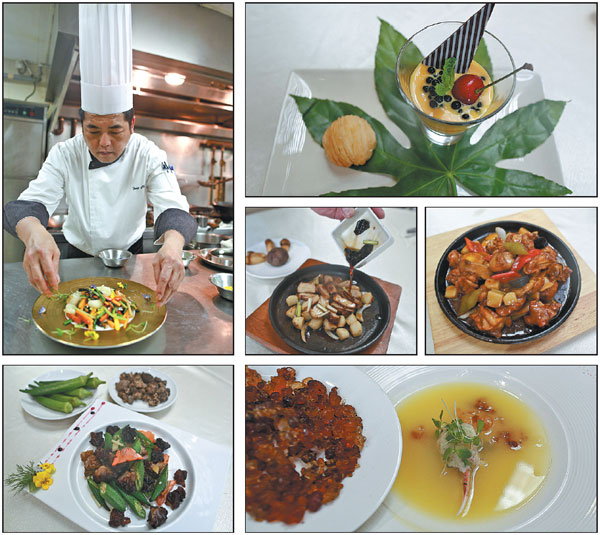Mushroom kingdom
As harvest peaks, earthy flavors are added to Chinese dishes for signature taste, Liu Zhihua reports.
A troop of raincoat-clad foragers are tramping through a forest in deep mountains damp from a recent rain, their eyes searching the ground for any trace of summer's treasured treats - wild mushrooms.
That scene is likely playing out all over Yunnan province, as summer - especially late July and early August - is mushrooms' harvest peak in the largest production area of China. As hot weather blankets the country, market stalls burst with the freshly plucked, earthy delights. Some go to local dinner tables, but plenty find their way to other parts of China and the world.
|
Master chef Tony Choo from Singapore updates dishes at JUN Chinese Restaurant and cooks wild mushrooms with an innovative twist on Cantonese techniques. Photos by Feng Yongbin / China Daily |
In Beijing, thousands of miles but a short flight from the kingdom of wild mushrooms, a vast group of restaurants will have fresh wild mushrooms on offer.
At JUN Chinese Restaurant of the Crowne Plaza Beijing Sun Palace (Yunnan Dasha), master chef Tony Choo has his own way to excite diners' palates with those wild delicacies, as he cooks them with an innovative twist on Cantonese techniques.
"Yunnan has a great array of food ingredients that always impresses me whenever I am there," says Choo, a Singapore native. "Locals often cook mushrooms with spices to make a heavy taste. That is good choice in the moist climate there, but in Beijing I think Cantonese cooking will be a better approach."
Choo had nearly 20 years of experience in Cantonese kitchens in Singapore, Hong Kong and Taiwan before he started working in the Beijing hotel restaurant in 2011.
Choo's grandfather came from Fujian province and he feels proud of his Chinese roots. He's fascinated with the abundance of ingredients on the Chinese mainland. He updates about 50 percent of the dishes on the JUN menu every year, and Yunnan is his favorite place to visit for culinary inspiration. He also visits Guangdong province and Fujian occasionally.
His most recent creation: assorted seafood stir-fried with tiger-paw mushrooms and garlic sprouts. His take on a common Cantonese dish is made remarkable by his use of the uncommon fungi, which in dried form can cost more than 4,000 yuan ($645) per kilogram.
The mushrooms have villi on their surface that requires painstaking effort to brush off, and they need to be soaked in water for a day before going into a wok. But their slight sourness and strong mushroom flavor go so well with seafood that the effort is well worth it.
The appetizing dish had 12 kinds of seafood and vegetables, which included shrimp, squid, peppers, parsley, turnip and Chinese toon shoots.
The slices of mushroom had a crisp coating and were tender inside. They tasted even better when they grew cold, and became juicier.
Tricholoma matsutakes, or pine mushrooms - another highly valuable variety that has a distinctive spicy fragrance and meaty texture - were roasted and served on a hot plate with black garlic.
The dish looked deceptively simple - just piles of mushroom slices dressed with a handmade sauce containing black garlic, a fruity, odorless fermented garlic. The hot plate needs to be at 60-70 C, so that the temperature will intensify the mushrooms' flavor and fragrance, but not be too hot and ruin them. As the chef slowly poured the sauce onto the plate, it fizzed and buzzed, radiating a tantalizing aroma. The black garlic, common in the highlands of Yunnan and nearby provinces, tasted vinegary and doesn't cause bad breath. The white and dark-brown mushrooms tasted slightly sour and sweet.
The chef told us with regret that the pine mushrooms he cooked were frozen ones. The flavor and aroma would be fuller if they were fresh, he says, but I found them very satisfying.
For the first time, I tried "walnut mushrooms", a type that has a black curlicue stem and cap.
Wok-fried with okra, the mushroom tasted like black fungus, but was crunchier and meatier, a good match with the young, fresh okra.
I also liked the bisque with pine mushrooms, peach-flower gelatin and crab claws. Chinese caterpillar fungus is simmered in chicken stock for days until it virtually dissolves, and then the pink-colored stock is used to braise the peach resin and crab, resulting in a soup that is sticky and flavorful.
As the mushroom harvest approaches its peak, Choo says he is looking forward to making more delicacies with those earthly delights.
Contact the writer at liuzhihua@chinadaily.com.cn



















